Hyundai Tucson Vs Honda CR-V: Which SUV is Right for You?

If you’re looking for two compact crossovers that stretch the definition of the word “compact,” you’ve come to the right place. It’s the Hyundai Tucson vs Honda CR-V.
The Hyundai Tucson and Honda CR-V are two of the most capacious offerings in the class. Not saying that’s their only stand-out characteristic, however: our reigning 2022 AutoGuide Utility Vehicle of the Year has dramatic styling and a tech-filled cabin on its side, while even in its twilight years, the CR-V has a smooth ride and has retained second-place on the sales charts.
With these two accounting for almost half a million sales on their own in 2021, they’re both popular picks. Which one suits you best? Here we dig into their specs and figures to find the answer.
Get a Quote on a New Hyundai Tucson or Honda CR-VHyundai Tucson vs Honda CR-V: Cabin Space
Tucson: Hyundai has given the Tucson a clean-looking cabin, with a wraparound dashboard design that flows down into the main central touchscreen. The center console is raised, with a push-button shifter keeping the primary controls close. Cloth seating is standard, as is typical for the class, while leather is available on higher trims. The top trim includes both heating and ventilation for the front seats.
The Tucson rides on a wheelbase measuring 108.5 inches (2,756 millimeters), which results in a spacious interior. Front headroom is 40.1 inches (1,019 mm) or 38.1 inches (968 mm) with the panoramic moonroof. Rear headroom is slightly less than the front without the glass (39.5 in / 1,003 mm) and slightly more with it (39.0 in / 991 mm). Legroom for the two rows is 41.4 and 41.3 inches (1,052 and 1,049 mm) front to back. Opting for the hybrid Tucson trims fractions of the front legroom and rear headroom.
SEE ALSO: Hyundai Tucson Hybrid vs Ford Escape PHEV ComparisonCR-V: The CR-V has a unique interior design, with a raised center console housing the push-button shifter. It can be a little jarring compared to just about anything else out there, but the ergonomics are sound. The controls are now closer to the driver’s right hand, and there’s no chance any drinks in the cupholders will get in the way. The materials are starting to show the CR-V’s age, though; it did launch in 2017, so some of the plastics and especially the fake wood date it.
The CR-V wheelbase measures 104.8 inches, but it lines up with the Tucson in all major measurements. Front headroom is 40.1 inches (1,019 mm), though that drops to 38.0 inches (965 mm) on models with the sunroof. Front legroom measures 41.3 inches (1,049 mm). Back-seat passengers enjoy 39.1 inches of headroom (993 mm) and 40.4 inches (1,026 mm) of legroom. Unlike the Hyundai, the Honda doesn’t lose any passenger space when opting for the Hybrid. The CR-V is slightly wider up front, but much more narrow in the back, where it gives up over four inches of hip room, 49.5 versus 53.9 inches (1,257 and 1,369 mm).
SEE ALSO: 2020 Honda CR-V Review: A Cross For The Weekend?Bottom Line: Despite its age, the CR-V is still one of the most spacious vehicles in the class. The Tucson just edges past it, and we’re fans of its more modern design.
Cargo Space and Towing
Tucson: Gas-powered Tucsons will swallow up to 38.7 cubic feet (1,096 liters) of stuff behind the rear seats, or a massive 80.3 cu-ft (2,274 L) with the 60/40-folding row tucked. Hybrid models drop the latter figure to 74.5 cu-ft (2,1110 L).
No matter the drivetrain, the Tucson maxes out at 2,000 pounds (907 kilograms) of towing capacity.
CR-V: Depending on the trim, the CR-V can prove even more cavernous than the Tucson. Stick to any gas trim below the Touring, and there’s 39.2 cubic feet (1,110 L) behind the seats. Opt for that top trim and the number shrinks to 37.6 cu-ft (1,065 L). The CR-V Hybrid—all trims—cut that figure to 33.2 cubes (940 L). Seat-down figures are 75.8 cu-ft (2,146 L) for the gas model, and 68.7 cu-ft (1,945 L) for the Hybrid.
Honda rates the gas CR-V at 1,500 lb (680 kg) of towing capacity—and nothing for the hybrid.
Bottom Line: If the half-cube of extra storage space in the lower-trim CR-Vs is a deciding factor for you, then that’s the choice—and we have some questions about your very specific needs. For everything else, the Tucson offers more storage space, and it wins the towing comparison, especially as the CR-V Hybrid just can’t do it.
SEE ALSO: Hyundai Tucson Hybrid vs Toyota RAV4 Hybrid Comparison: Fuel-Sipping Family HaulersTechnology and Features
Tucson: Hyundai fits the lower-level Tucsons with an 8.0-inch touchscreen—larger than even the optional unit on the CR-V. What’s more, this one supports wireless Apple CarPlay and Android Auto. Higher trims swap it out for a 10.25-inch screen, though strangely require a cord for smartphones. The large panel below the screen houses a variety of touch-sensitive buttons.
Depending on trim, buyers can net features like a hands-free power liftgate, wireless charger, dual-zone climate control, and other creature comforts. A Bose sound system also shows up mid-tier. At the top of the pile, the Limited/Ultimate adds heated rear seats, memory seating, a panoramic glass roof, around-view monitor (with lane-view), and more.
CR-V: The 2022 CR-V LX is one of the remaining few vehicles out there that you can buy without a touchscreen or Apple CarPlay/Android Auto. A 5.0-inch color LCD screen is standard, but on every trim beyond that, Honda fits a 7.0-inch touchscreen running the previous version of its infotainment, and capable of mirroring both major phone platforms.
Moving up beyond the base model unlocks dual-zone climate control (single is standard), heated front seats, and Honda’s HondaLink mobile phone app. Higher trims add yet more goodies, like second-row USB charge ports, a nine-speaker audio system, wireless charger, and satellite navigation with traffic reports. Leather seating shows up on the EX-L, which includes a 12-way power-adjustable driver’s seat with memory, and four-way power adjustments for the front passenger.
SEE ALSO: 2020 Honda CR-V Hybrid First Drive ReviewBottom Line: As the older model (and indeed, the oldest model in the segment), the CR-V can’t keep up with the newer Tucson’s tech suite.
Hyundai Tucson vs Honda CR-V: Powertrains
Tucson: Hyundai fits gas-only Tucsons with a 2.5-liter, naturally-aspirated four-cylinder. It sends its 187 horsepower and 178 pound-feet of torque through an eight-speed automatic, connected to either standard front-wheel drive or optional all-wheel drive.
There are two hybrid options as well. Both use the Hyundai group’s familiar 1.6-liter turbocharged four-cylinder, paired to an electric motor and six-speed automatic. Pulling charge from a 1.49-kWh battery pack, the Tucson Hybrid produces 227 hp and 258 lb-ft. A plug-in hybrid swaps in a larger 13.8-kWh battery pack and stronger electric motor, with horsepower up to 261. Both hybrid models come with AWD as standard.
SEE ALSO: Subaru Forester vs Chevrolet Equinox Comparison: Underdog FightCR-V: Honda simplified the CR-V lineup a few years ago, with the gas car sticking to only the brand’s 1.5-liter turbo four-cylinder. It produces a useful 190 horsepower and 179 lb-ft. Those numbers barely shade the Tucson, but torque plateaus from 2,000 to 5,000 rpm, which makes for smooth inner-city progress. Front-wheel drive is standard, with AWD optional (and standard on higher trims).
The CR-V Hybrid employs a larger, naturally-aspirated 2.0-liter inline-four, working alongside two electric motors and a 1.4-kWh battery pack. Power jumps to 212 hp and 232 lb-ft. AWD is the only option for the hybrid. The transmission is what Honda calls “eCVT,” which eschews a traditional transmission for a wet-clutch pack between the two electric motors. The gas engine powers one, which acts as a generator, while the other sends power to the wheels.
Bottom Line: On the gas side, the CR-V’s engine is the stronger everyday choice. Flip to hybrid, and the Hyundai has the edge on power and driving manners, thanks to that six-speed auto. If you want a plug-in hybrid, there’s only one choice.
Fuel Economy
Tucson: The gas-only Tucson posts 26 mpg city and 33 mpg highway, for a combined rating of 29 mpg. (Canadian figures are 9.1, 7.1, and 8.2 L/100 km, respectively.) Opting for AWD knocks those numbers down to 24/29/26 mpg (9.9/8.0/9.0 L/100 km).
Switching over to the regular hybrid in lower-level Blue trim boosts the numbers to 38 mpg across the board. The rest of the full hybrid lineup is slightly less efficient, posting 37/36/37 mpg (6.3/6.6/6.4 L/100 km), respectively.
The Tucson PHEV has a 35 mpg combined (6.7 L/100 km) rating, or an 80 mpg-equivalent (2.9 L/100 km) one when taking pure-electric driving into account. Hyundai says it’ll run 33 miles (53 km) on nothing but electrons.
SEE ALSO: Mazda CX-30 vs Mazda CX-50 Comparison: The InbetweenersCR-V: Honda quotes a useful 28 mpg city, 34 mpg highway, and 30 mpg combined for the front-drive CR-V. (Canadian figures are 8.3, 7.0, and 7.7 L/100 km, respectively). Sending power to the rear wheels drops the CR-V AWD scores to 27/32/29 mpg (8.7/7.4/8.1 L/100 km).
Hybrid figures jump up to 40 mpg city, 35 mpg highway, and 38 mpg combined. There are no official Canadian figures, because the CR-V Hybrid isn’t actually sold in Canada.
Bottom Line: The Honda is more frugal in its gas form, and can be in hybrid form too, if you spend more time driving in the city than the highway.
SEE ALSO: Toyota RAV4 vs Honda CR-V: Which Crossover Is Right For You?Hyundai Tucson vs Honda CR-V: Safety
Tucson: Every trim level of the current Tucson comes with automated emergency braking, lane keep assist, lane follow assist, and automatic high beams. Moving up one trim beyond the base model adds blind spot monitoring, rear cross-traffic alert, safe exit assist, and adaptive cruise control. At the top of the lineup, buyers gain access to a 360-degree camera, blind-spot view monitor, Highway Driving Assist, rain-sensing wipers, and front parking sensors.
The Tucson earned a four-star safety rating from the National Highway Traffic Safety Administration (NHTSA) and a Top Safety Pick + title from the Insurance Institute for Highway Safety (IIHS).
CR-V: The CR-V earns a five-star overall rating from the NHTSA, with a four-star score for front passenger side collision. Meanwhile, it scores a Top Safety Pick designation from the IIHS, though that only applies to vehicles with the LED headlights.
Automated emergency braking, lane departure alert, road departure mitigation, lane-keep assist, auto high-beams, and adaptive cruise control are all standard, on all CR-Vs. Blind spot information and Cross Traffic Monitor show up from the mid-level EX onwards.
Bottom Line: Both vehicles include the same level of safety features in their lower trims. The Tucson nudges ahead as you move up the trim lines, however, with useful features like a surround-view monitor, blind-spot view, parking sensors, and safe exit assist.
Styling
Tucson: With angular looks straight off the show car circuit, the Tucson is a strong statement in a segment not always known for them. The way the headlights seamlessly integrate into the grille advances a cool hidden-lighting approach Hyundai started with the current Sonata. Squint, and you’ll see a little bit of Lamborghini Countach in those squared-off wheel arches. 17-inch wheels are standard, but the Tucson looks best on the 19s you’ll find on higher trims.
CR-V: The CR-V is at once instantly recognizable, and yet blends into the background. The wedge-shaped headlights connect to a reasonably-sized grille, and the 2020 facelift introduced a contrasting element in the lower bumper to visually lower the whole car. The CR-V maintains its traditional vertical taillights, with larger lower sections pushed right to the edge of the tail, emphasizing the SUV’s width.
SEE ALSO: Subaru Forester vs Nissan Rogue: Which Compact Crossover is Right for You?Bottom Line: The Tucson definitely pushes the envelope. The jury is out on how well that design will age, however. As ever, you’ll have your particular preferences.
Pricing and Value
Tucson: The Tucson family starts with the SE FWD trim in America, listing at $27,095 including destination. From there, buyers can move through the SEL ($28,395), sporty N Line ($32,495), off-road-styled XRT ($33,145), and Limited ($36,595). Adding AWD is a $1,500 upcharge.
Hybrid buyers have three trims to choose from. The Tucson Hybrid Blue ($31,045) anchors the lineup, with the SEL Convenience ($33,645) and Limited ($39,345) above it. Want the plug-in hybrid? It comes in SEL ($36,695) and Limited ($44,495) flavors, and should be eligible for rebates.
Canada’s lineup is wholly different, even the trim names. Hyundai dubs the base model Essential in the land of Timbits, which lists for $29,724 CAD including destination. From there, buyers can move up toPreferred ($32,124 CAD), Urban (nee XRT, $39,124 CAD), and N Line ($39,124 CAD). The latter two trims include AWD as standard; it’s a $2,000 CAD upgrade for the others. Hyundai Canada keeps the top Tucson trims hybrid-only, so you’ve got the Luxury Hybrid ($40,924 CAD), and Ultimate Hybrid ($43,624 CAD) at the top of the food chain. These latter two trims are also available in PHEV form for an additional $6,400 CAD, though they then should be eligible for rebates just as they are in the US.
CR-V: The CR-V lineup starts with the LX FWD, coming in at $28,045 including destination. The trim walk then takes in the value-oriented Special Edition ($29,245), EX ($30,555), EX-L ($33,145), and Touring ($37,845). AWD is a $1,500 upgrade on all trims except Touring, where it is standard.
The CR-V Hybrid is offered in three flavors, with the EX anchoring the lineup at $33,255. Next comes the EX-L at $35,845, and the Touring at $39,045. For reference, that’s an additional $1,200 over the equivalent 1.5-liter AWD model.
Canada’s lineup takes a different approach, and skips right over the CR-V Hybrid. The LX-2WD grounds the lineup at $33,420 CAD, and the jump to AWD brings it to $36,220 CAD. The LX models do get a few extra niceties over their US counterparts, however, such as Android Auto and Apple CarPlay. From there you’ll find the Sport ($40,120 CAD), EX-L ($41,920 CAD), Touring ($45,520 CAD), and the murdered-out Black Edition ($47,320 CAD).
Bottom Line: No matter which way you slice it, the CR-V is the pricier of this pair. That gulf will only grow when the next-generation model touches down.
Hyundai Tucson vs Honda CR-V: In Conclusion
It’s easy to see why the Honda CR-V has become such a sales juggernaut. It minimizes friction points: it’s comfortable, spacious, easy to see out of, and easy to use. It’s pricey, but Honda has built up the CR-V’s reputation over 25 years.
The Tucson’s styling might not be for everyone, but its combination of value, tech, and smooth hybrid powertrains is hard to ignore. Now it also boasts one of the most spacious interiors in the class, too. The Tucson is our Utility Vehicle of the Year for a reason—but we encourage you to drive both before making up your mind.
Become an AutoGuide insider. Get the latest from the automotive world first by subscribing to our newsletter here.

Kyle began his automotive obsession before he even started school, courtesy of a remote control Porsche and various LEGO sets. He later studied advertising and graphic design at Humber College, which led him to writing about cars (both real and digital). He is now a proud member of the Automobile Journalists Association of Canada (AJAC), where he was the Journalist of the Year runner-up for 2021.
More by Kyle Patrick



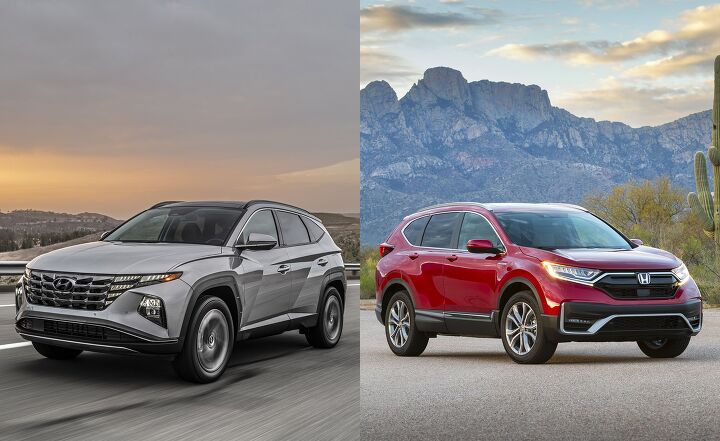




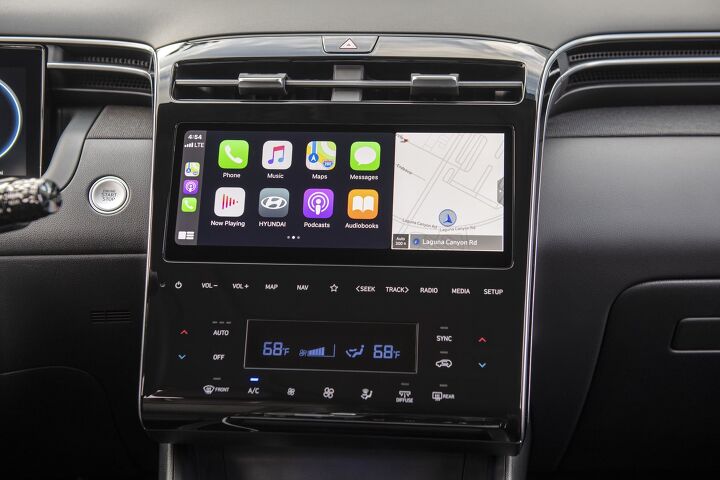




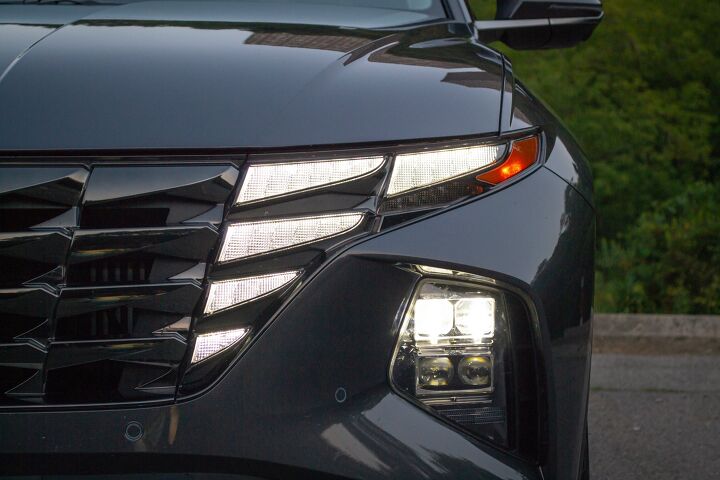

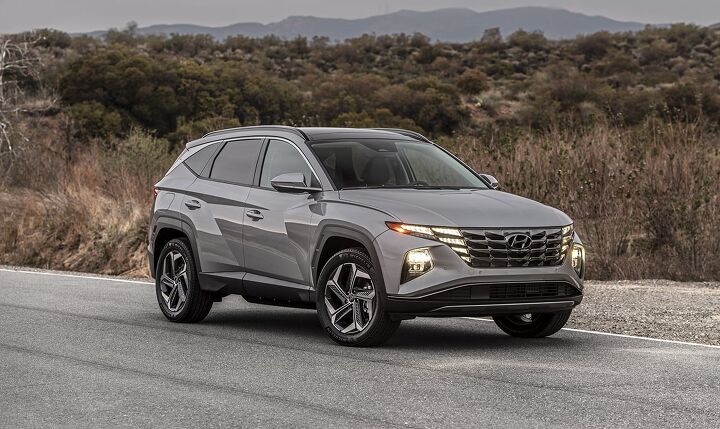

















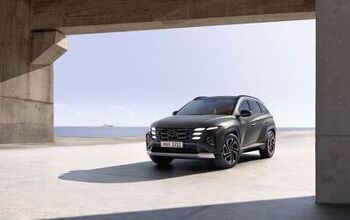
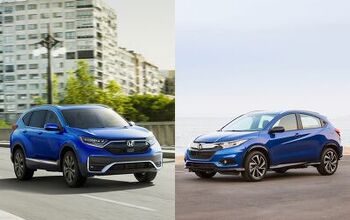
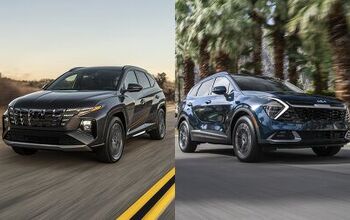
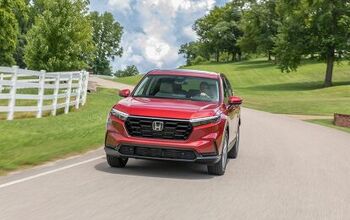



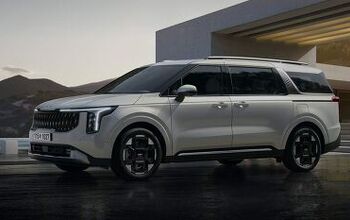

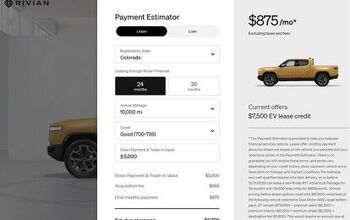
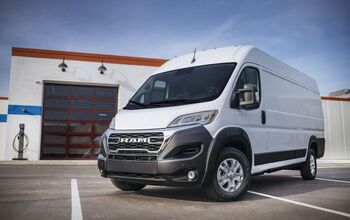


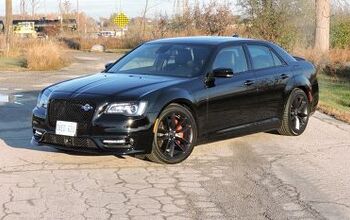
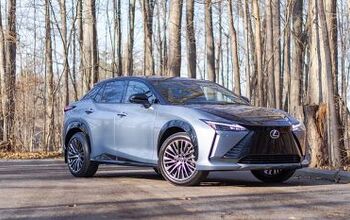
Comments
Join the conversation
Oops, I meant Honda ;)
The older models and lower trims have the gear shift. The newer and/or high trims have the push buttons to shift.